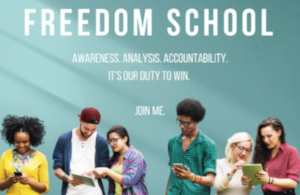
Good morning!
The very first time I heard about Critical Race Theory (CRT) I was in college. I hadn’t learned about it in school because I attended predominantly white institutions. During this time I was trying to figure out why the education I was paying for was not meshing with the lived experience I possessed being a black woman from the south side of Chicago. It was like I was living in a totally different world than what my professors were teaching about.
CRT showed me I was.
A friend of mine said that Freedom School is basically my way of bringing Critical Race Theory to the folks in my life. She’s was right! I know that Critical Race Theory sounds incredibly academic but I have a feeling many of you are already doing work based on CRT and just don’t know it, so I pulled together a little overview for y’all.
Brief History: In the 1970’s and 80’s a group of lawyers, activists, and legal scholars* recognized that they needed a new framework to combat racism and oppression in America. They blended concepts from critical legal studies and radical feminism with the influences of the Black Power and Chicano movements of the time and critical race theory was born. At first it was mainly referenced in legal scholarship, but now it’s used across many different fields and disciplines. You can read a much more detailed history here.
Critical race theory asks us to consider how we can transform the relationship between race, racism, and power and work toward the liberation of People of Color.
How many of y’all where asked this in school? I would guess too few if any.
These super smart scholars identified 5 basic tenets** of Critical Race Theory –the core components.
1. The centrality and intersectionality of racism. Racism exists everywhere in American life –from within our own thoughts, to our personal relationships, to our places of work, to our educational and judicial systems. CRT says that racism isn’t just the actions of individuals but that it’s embedded in our institutions, systems, and culture. It is our way of life.
2. The challenge to dominant ideology. In law and other arenas there is a belief that concepts like neutrality, objectivity, colorblindness, and meritocracy can be fully actualized. CRT says, “not so fast, how can one be truly neutral on issues of race when racism is baked into the fabric of America?” (Ummm, it can’t).
CRT pointed out that claims of objectivity and colorblindeness can be ways in which dominant groups camouflage their interests in order to get what’s best for them—check out housing and education in this country if you don’t believe me.
3. The commitment to social justice. CRT as a framework acknowledges how all oppression interrelates and focuses on eradicating racism and other forms of oppression by centering People of Color and taking a stance on issues of social justice. People of Color have been fighting before this country was formed for justice and this has never stopped in some form or fashion.
4. The importance of experiential knowledge. This is huge y’all, CRT says that the lived experiences of People of Color however expressed (storytelling, family history, biographies, scenarios, parables, cuentos, chronicles, narratives)** are crucial to understanding racism and oppression, that they are necessary in our quest for liberation. From the academic, to legal, to activist arenas lived experience must be taken seriously.
5. The use of an interdisciplinary perspective. CRT draws from many different fields in order to create a powerful and nuanced framework for engaging with race and racism. There is no one answer, no one discipline, no one path to freedom. CRT says let’s use all the tools in the toolbox to help educate folks so we can get free.
Of course CRT is more theoretical then I have described but this is it boiled down at its core. CRT is the education that most of us never got—or we did not get until after we left school. It is an education that values challenging the status quo and prioritizing lived experiences.
It is rooted in collective learning and community building and ain’t nothing wrong with that.
Let’s go get free together.
*Scholars at the forefront of developing CRT: Derrick Bell, Richard Delgado, Mari Matsuda, Kimberle Crenshaw, Charles Lawrence, Neil Gotanda, Patricia J. Williams, Angela Harris
**Solorzano, D., & Yosso, T. (2000). Toward a critical race theory of Chicana and Chicano education.
If this overview left you wanting for more, Freedom School starts next week!
You can watch me talk all about it here.

